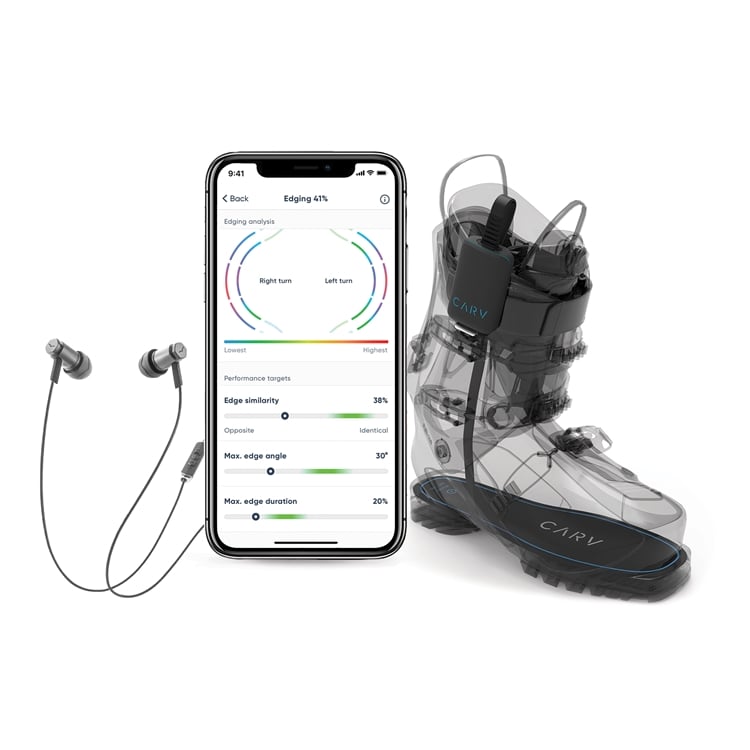Nordic Semiconductor today announces that MotionMetrics, a London, UK-based consumer electronics startup, has selected Nordic’s nRF52832 Bluetooth® Low Energy (Bluetooth LE) System-on-Chip (SoC) to provide the processing power and wireless connectivity for its ‘Carv’ digital ski instructing wearable. The wearable is designed for training, competing, and challenging friends on the ski fields.
Carv comprises two ultra-thin footbeds with MEMS accelerometers, gyroscopes, magnetometers, and capacitive pressure sensors that fit underneath the linings of any ski boots and are connected to a slim ski tracker attached to the boot’s Velcro power strap. The built-in sensors track the skier’s motion and pressure distribution during every turn throughout each individual ski run, providing a comprehensive data set across four key skiing categories—balance, edging, rotation, and pressure—based on 35 different metrics. The nRF52832 SoC’s powerful 64MHz, 32-bit Arm® Cortex® M4 processor with floating point unit (FPU) ably supports the application’s complex Floating Point and Digital Signal Processing (DSP) computations to offer real time feedback from the sensors.
Using Nordic SoC-enabled low latency Bluetooth LE connectivity, the device wirelessly relays the comprehensive metrics and analysis to the iOS- and Android-compatible Carv app on the user’s Bluetooth 4.0 (and later) smartphone. The app provides easy-to-understand graphical insights and ‘Ski:IQ™’ performance scores across the four key skiing categories, along with ‘real time’ professional audio coaching with actionable feedback. From the app, the user can choose between different instruction modes to suit their goals. In ‘free session’ mode, Carv silently tracks the user’s skiing performance for review, analysis, and advice while stopping, between runs on a chairlift, or when the session has finished. In ‘training’ mode, Carv provides instant feedback and helpful verbal tips on how to improve, for example “keep your weight forward” and “apply more pressure to your outside ski”, through the user’s earphones/headphones as they ski.
Nordic’s nRF52832 multiprotocol SoC combines the Arm processor with a 2.4GHz multiprotocol radio (supporting Bluetooth 5.2, ANT™, and proprietary 2.4GHz RF protocol software) featuring -96-dB RX sensitivity, with 512kB Flash memory and 64kB RAM. The SoC is supplied with Nordic’s S132 SoftDevice, a Bluetooth 5.2-certifed RF software protocol stack for building advanced Bluetooth LE applications. The S132 SoftDevice features Central, Peripheral, Broadcaster and Observer Bluetooth LE roles, supports up to twenty connections, and enables concurrent role operation. Nordic’s software architecture also includes a clear separation between the RF protocol software and MotionMetrics’ application code, simplifying development and ensuring the SoftDevice doesn’t get corrupted when developing, compiling, testing, and verifying the application code.
Carv devices employ Li-Poly batteries to provide several days of regular usage before recharge, thanks in part to the ultra low power characteristics of the Nordic SoC. The nRF52832 has been engineered to minimize power consumption with features such as the 2.4GHz radio’s 5.5mA peak RX/TX currents and a fully-automatic power management system that reduces power consumption by up to 80 percent compared with Nordic’s nRF51 Series SoCs.
“The Nordic SoC’s Arm Cortex M4 processor with FPU meets Carv’s computational requirements for real-time sensor fusion,” says Jamie Grant, CEO of MotionMetrics. “Nordic’s technical support, reference designs, and software development kits (SDKs) with working examples also proved extremely helpful for us in the development process.”

